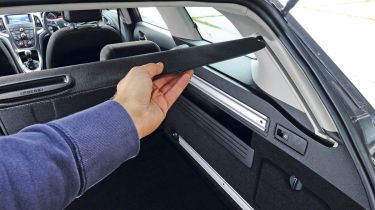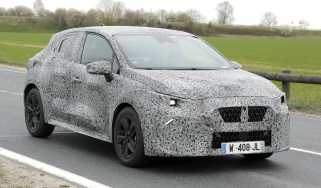Vauxhall Astra ST
Practical five-door gets a dose of style in its latest incarnation
What's in a name? The previous load-carrying Astra was called the Estate, but Vauxhall has badged the latest model Sports Tourer. Does the newcomer live up to its title, or will it flatter to deceive?
The company has certainly paid attention to the styling, as the extra bodywork has been neatly incorporated. The Astra’s sleek profile and well judged proportions are in contrast to the boxy look of the Golf. From the outside, the Sports Tourer justifies its billing, then – and the stylish lines haven’t come at the expense of space.
With the rear seats in place, the load bay offers 30 litres more room than before, at 500 litres. That puts the Vauxhall in the middle ground in this test.
The boot is well thought out and beautifully trimmed, too, with shallow underfloor stowage and side rails (£110). And SRi models upwards get the FlexFold system, whereby the rear seatbacks drop forwards at the touch of a button. To maximise capacity, you can tumble the seat squabs forward first, which helps to provide the flattest load area of our trio. And you don’t need to remove the rear headrests to achieve this.
Up front, the Sports Tourer is identical to the five-door Astra, so it feels like a quality product. The angled dash is attractive and the materials first class.
Used - available now

2021 Mercedes
A-Class
24,149 milesAutomaticDiesel2.0L
Cash £19,676
2021 Ford
Grand Tourneo Connect
24,730 milesManualDiesel1.5L
Cash £17,699
2019 Mercedes
GLA
45,285 milesAutomaticPetrol1.6L
Cash £14,399
2024 Kia
Niro
17,000 milesAutomaticPetrol1.6L
Cash £23,030There are a few niggles: the centre console appears busy, and although the switchgear is smart, some of it is fiddly to operate. It can also look grubby as greasy fingermarks show up on the buttons’ rubberised matt finish. Elsewhere, the gearlever is located too far back, and while the driving position is fine, the steeply raked windscreen pillars cause large blind spots.
The Astra provides plenty of equipment, with the stylish multifunction steering wheel operating the standard cruise control. SE trim also benefits from ambient lighting, which gives the cabin an upmarket appearance at night.
This executive mood is enhanced by strong refinement – at motorway speeds, road and wind noise are well isolated from the cabin. The suspension is less adept. Although it copes well enough with crests and big bumps, at lower speeds small imperfections ripple into the cabin. This trait was no doubt highlighted by our test car’s optional 18-inch wheels.
There’s plenty of grip and the Sports Tourer responds to steering inputs with vigour. It darts into corners, but provides precious little feedback through the wheel. As a result, it doesn’t inspire as much confidence or provide as much driver engagement as its rivals.
Yet the biggest problem is the engine. Even though the Vauxhall costs more than the VW and Renault, its diesel is smaller and less powerful. The 1.7-litre CDTI gives away 40Nm of torque to the Golf, and feels breathless and lethargic. While power delivery is linear, it’s a sluggish performer, and not as smooth or refined as rivals.
At the test track, the Astra trailed the Golf from 0-60mph by one second, with a time of 11.2 seconds. Plus, it was slower to respond in our in-gear tests.
The Renault was even faster. It boasts only 5bhp and 20Nm more than the Vauxhall, but this advantage – combined with an 89kg weight saving – helped to make the Mégane the swiftest car of our trio. Yet what the Astra loses against the clock it aims to claw back at the tailpipe, as its CDTI engine is the cleanest here.
That makes the Vauxhall the cheapest company car. Private buyers will be less enamoured, as it’s likely to suffer from the same heavy depreciation as its predecessor. Our experts predict it will be worth over £3,000 less than the cheaper, more powerful Golf Estate in three years’ time.
The £30 annual road tax bill is a bonus, but against such a potential shortfall, the slower and less engaging Vauxhall has its work cut out here.
Details
Chart position: 3
WHY: New Sports Tourer adds practicality to the Astra’s upmarket nature. The 1.7 CDTI is clean, too.






